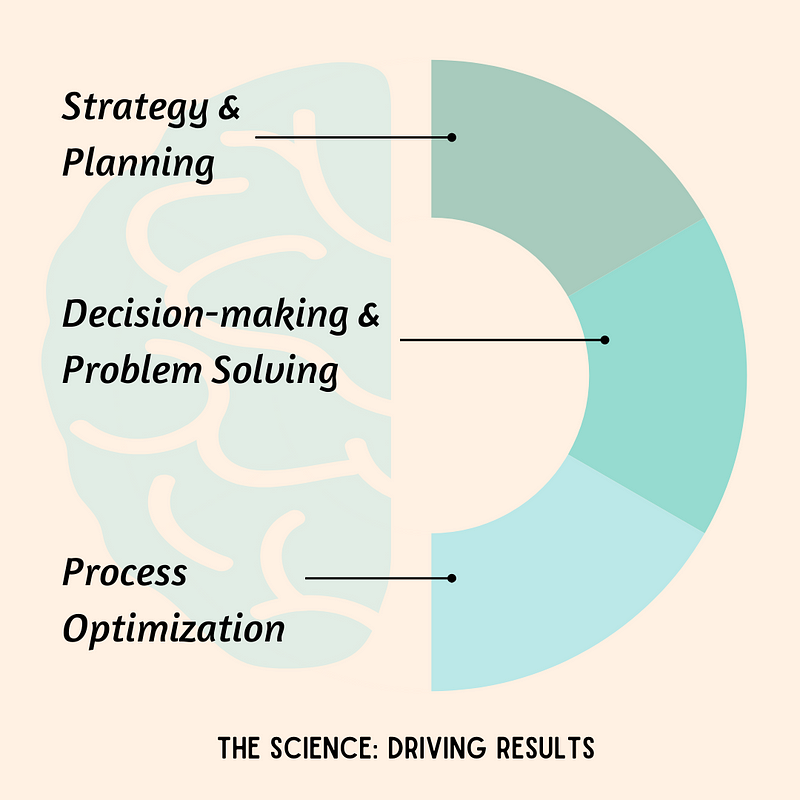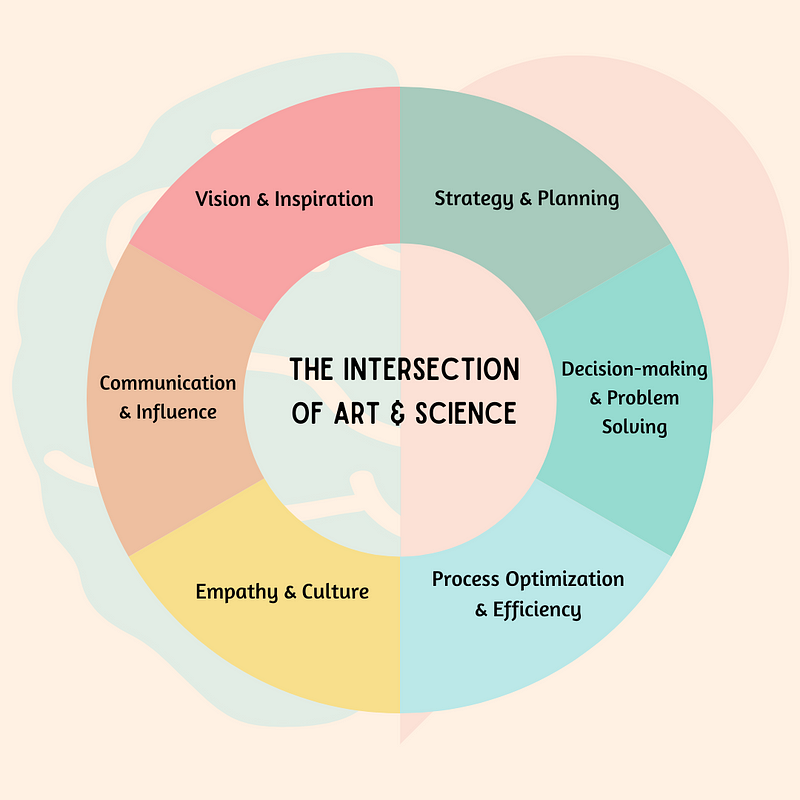
Heart vs Brain: Is Leadership an Art or a Science?
This has got to be one of the longest-standing debates in the history of leadership:
Is Leadership an Art or a Science?
As you will soon find out, the answer to that question is intricately complex, yet strikingly simple.
In this article, I will discuss both the art and the science of leadership, how these dimensions interplay with each other, and what most leaders are getting wrong about them.
We will then conclude with the final verdict, and (hopefully) put an end to the long-standing debate!
The Art of Leadership

“Art is not what others see. It is how you make them feel.” — Author
The Art of Leadership focuses on the emotional or human element.
At the very core, as a leader you value human connections.
In the article Good to Great: The Most Overlooked but Critical Skill of a Leader, I discuss how your people are your greatest asset.
As a leader, you inspire your team with a vision to get them motivated and excited about the future. You set the tone of communication, and use that to influence change. You embody values that resonate with you and your teams, which ultimately define the culture in your organization.
Vision and Inspiration
As a leader, you inspire your teams with a compelling vision.
You paint a vivid picture of the future, and ignite passion and enthusiasm in your team to follow you in your mission.
As I discussed in the article You Hit the Bull’s Eye. Was It the Right Bull?:
The most important goal of a leader is to have the right goal.
You need to make sure you and your teams are always headed in the right direction, and continue to adjust courses along the way.
Your teams should be emotionally connected to the vision, with a clear sense of purpose and conviction.
Communication and Influence
Communication is an integral part of leadership.
In the article From Clever to Clear: The Simple 2N Formula You Can Use to Level Up Your Communication, I discuss how effective communication plays a key role in fostering trust and collaboration.
As a leader, you master the art of persuasion using words and actions.
You learn how to craft your words, and tailor them so they resonate with your teams and stakeholders.
And you need to do this with authenticity and transparency.
Your teams should be able to feel the message, not just hear it.
Empathy and Culture
In The 7 Counterintuitive Habits of Highly Effective Leaders, I discussed how cultivating empathy is one of the cornerstone habits of great leaders.
As a leader, you need to put yourself in others’ shoes, and understand their perspectives, needs, and aspirations.
You need to let go of your own ego and stereotypes, and open up your mind to other perspectives.
Doing this will help you to build strong, trustful relationships, and create an inclusive work environment.
Your teams will feel a strong sense of belonging, and feel cared for.
The Science of Leadership

“Science is simply common sense at its best, that is, rigidly accurate in observation, and merciless to fallacy in logic.” — Thomas Huxley
The Science of leadership focuses on the analytical element.
In the article Mind Boxing: How Leaders (Should) Spend Their Time (The 6 Box Framework), I discuss a framework that leaders can use to focus on what matters the most to maximize business results.
As a science-driven leader, you strategize, plan, and strive to make objective decisions by leveraging the power of data, analytics, and evidence-based practices.
You use analytical approaches to drive improvements and efficiencies in your organization.
Strategy and Planning
Strategic thinking and planning are important aspects of your role as a leader.
As discussed in The 6 Skills You Need to Become a Strategic Leader, you need to be intimately aware of your team’s strengths, weaknesses, as well as external opportunities and threats, and use those to come up with an optimal strategy for your organization.
You set goals, allocate resources, and establish performance metrics that you can then use to measure your progress toward those goals.
And you continuously adapt your strategy along the way as new information becomes available, and as circumstances change.
Decision-Making and Problem-Solving
As a science-driven leader, you love the power of data to make decisions.
As I discussed in How Decision-Making is Like Driving a Vehicle, leaders look at various factors, stakeholders, outcomes, and risks associated with the decisions before arriving at an outcome.
You apply analytical rigor whenever you are presented with a business problem to solve.
You weigh the pros and cons, do a cost-benefit analysis, or run scenario planning, etc. to mitigate risks, and make informed, measured decisions.
Even for your teams, you establish clear expectations, set measurable goals, and track progress against the goals using data-driven metrics.
For you, data is the keyword.
Process Optimization and Efficiency
As an analytical leader, you see inefficiencies as your enemies, and put all your energies and forces against them.
In one of my favorite leadership books (that I picked up as part of my MBA) — The Goal — the author describes the Theory of Constraints, and how managers should be constantly on the lookout for bottlenecks and eliminate them as they find them.
As a leader, you are relentlessly focused on reducing waste and improving productivity while reducing costs.
You advocate for agility and automation to improve efficiencies and team velocity.
You believe in the power of continuous improvements.
The Intersection of Art and Science

From the human element to the analytical element, the art and science of leadership have strong interplays and interconnections.
In Good to Great: The Most Overlooked but Critical Skill of a Leader, I discussed the strong interdependence between People and Results. You cannot expect results from your team without first ensuring they are set up for success.
As an example, you use the art of leadership to establish a vision to inspire your teams. But in order to make that vision a reality, you use the science of leadership to define a strategy and plan that the team can use to execute.
As another example, you use the human element to influence your team and stakeholders. And, you use analytical rigor to define goals and metrics that you will use to measure progress.
As you can tell from the examples above:
Great leaders are those who seamlessly integrate the art and the science of leadership.
The Final Verdict
Time to revisit the original question:
Is Leadership an Art or a Science?
By now, the answer should be clear:
Leadership is neither an Art nor a Science. Leadership is an intricate mix of both elements.
The greatest leaders can strike just the right balance, and leverage the power of both the art and the science.
These leaders, by mastering both dimensions, can leverage the art of human connection to inspire their teams, while maintaining the scientific rigor necessary to drive business results.
Like my writing?
If you liked this post, I would appreciate some claps👏 as a form of encouragement. Thank you!
To read similar content you can follow me (Gaurav Jain) and subscribe to get these posts delivered directly to your Inbox. Check out my profile for other ways to connect with me.
Feedback is a gift! I would love to hear your thoughts and suggestions in the comments below 🙏
If you liked this, you may want to check out these related articles:
- Mind Boxing: How Leaders (Should) Spend Their Time (The 6 Box Framework)
- The 7 Counterintuitive Habits of Highly Effective Leaders
- The 6 Skills You Need to Become a Strategic Leader
- The Dumbest Mistake Leaders Make in Communication
- From Clever to Clear: The Simple 2N Formula You Can Use to Level Up Your Communication
